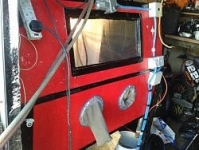sorry for the delay and lack of info , thanks for all the replys ,
i built this blast cabinet for home restoration of parts off motorcycles and cars , since then i have purchased a second hand but verry good vapour blasting machine to use for buisnes use , check out parts i have blasted :facebook vapour blast hull:, i still use the one i built at a friends workshop and he uses it every week most days and its still running as good as ever, i will post a new write up and step by step build soon of a new but smaller wet blast cabinet im building for another friends garage at home, this cabinet was built using only cheap osb board then fibre glassed for a solid and water proof finish , at first it was just a project to see if it was possible for it to work with good results , and it did, the key to making this cabinet work so well is to get the right amount of media /water/air all mixed correctly, the media and water needs mixing in the hopper and agitating evenly to work well. i use the 1000ltr a min pump split into 2 pipes , one pipe to the gun and one back into the hopper to mix the slurry, it took me a while to dial in the best way to get things mixing well. trial and error, i use a supper fine glass bead media and i purchase it from a uk shop called machine mart, unsure of the mesh but its the only size they sell. typicaly the media will only last around 10 hours before the parts that are being blasted start becoming duller , i then change out the media and replace it, i dry out the old glass beads and reuse them in the dry blast cabinet , so i get good use out of them, as for dust , there is 0 dust as the water containes and particals, just above the water line i have an outlet tube what runs to a settling tank, any particals of used bead or dirts from parts usualy floats to the top, so as im using the rinse hose the water level rises and excess water flows out through the outlet and into the settle tank, an easy was to flush out dirt and muck and helps keep the water inside verry clean, i offten run the pump and leave the rinse gun on for around half an hour to clean out any crud and clean the water , water leaves the settle tank and down the drain with 0 partics exiting into the drain, the settle tank has baffles in between to catch any crap from escaping.. the compressor i ran was 28cfm , you need allot of air , i also used a windscreen motor and wiper from a car to keep the window clean, also works well, any more info just drop me a message 3 blast vids also at youtube Mrjoshovhull



 LinkBack URL
LinkBack URL About LinkBacks
About LinkBacks


 Reply With Quote
Reply With Quote





Bookmarks